International Journal of Wireless and Microwave Technologies @ijwmt
Статьи журнала - International Journal of Wireless and Microwave Technologies
Все статьи: 574
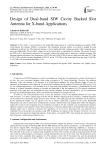
Design of Dual-band SIW Cavity Backed Slot Antenna for X-band Applications
Статья научная
In this article, a novel design for the bandwidth improvement of a substrate integrated waveguide (SIW) cavity-backed slot antenna (CBSA) is presented. The introduced structure utilizes an inverted L-shaped slot and unbalanced metalized vias. The proposed antenna is of low height and holds a planar geometry while sustaining lower losses and lightweight. The inverted L-shaped slot at the bottom plate is responsible for radiation. The quality factor of the SIW cavity is significantly reduced by the inverted L-shaped slot which leads to attaining a wideband response. The proposed antenna resonates at two frequencies 9.4025 GHz and 10.0075 GHz in the first band from the range 9.27 GHz to 10.13 GHz with the fractional bandwidth of 8.915% and at 12.07 GHz in the second band from the range 11.96 GHz to 12.2 GHz with fractional bandwidth of 1.9%.
Бесплатно
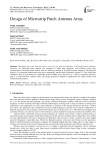
Design of Microstrip Patch Antenna Array
Статья научная
Throughout the years there has been a crisis for low gain and efficiency in Microstrip patch antennas. Therefore, the microstrip patch antenna was designed for better gain, directivity and efficiency using array configuration of microstrip patch antenna with low dielectric constant at 10.3GHZ resonant frequency. The proposed design is of a triangular shaped patch array and a substrate RT duroid-5880 of dielectric constant 2.2. The results after simulation shows a good return loss, bandwidth around 950Mhz-1Ghz, directivity of 11.4db in a particular direction, gain of 11.4 dB with 99% radiation effect. The design proposed is helpful for applications like military defence and communication purposes.
Бесплатно
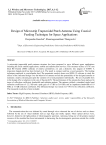
Статья научная
A microstrip trapezoidal patch antenna structure has been proposed to serve different space applications including the fixed satellite applications, mobile and radiolocation services. This structure utilizes a 0.787 mm thick RT Duroid (5880) substrate of relative permittivity 2.2 and a dielectric loss tangent of 0.0009. A trapezium shaped patch has been formed on it. The patch is compact and has a novel geometry. The feeding technique employed is coaxial/probe feed. The parametric analysis done over HFSS-15 software to study the effects of the structural design over the behavior of antenna reveals the potentiality of the designed antenna to maintain a nearly constant gain upon the variation of several parameters individually. The use of parallel slots in the design offer a reduction in the size of the patch [5]. The performance of the antenna has been analyzed in terms of reflection coefficient, bandwidth and radiation pattern. The antenna yielded a simulated single band reflection coefficient of -22.5 dB and a peak gain of 4.7 dBi at 3.64 GHz and an impedance bandwidth of 10 MHz at -10 dB reflection coefficient. The fabricated design was tested over VNA for its reflection coefficient. The measured results have been included.
Бесплатно
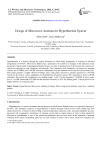
Design of Microwave Antenna for Hyperthermia System
Статья научная
Hyperthermia is a thermal therapy for cancer treatment in which body temperature is exposed to elevated temperature of 40-42oC. Microwave ablation has a potential to be sensitive to changes in the dielectric tissue parameters which results in damaging abnormal tissues. In order to produce heat in the focused area microwave signals are adjusted in time, frequency and strength. The commonly used frequencies in microwave imaging systems are 415MHZ and 2.45GHZ which are transmitted from the antennas enclosing the relevant body part. This paper presents a highly efficient E-Shape micro strip patch microwave antenna operated at 2.45 GHz which can be used in various applicators for hyperthermia treatment system. The simulation is done on IE3D simulator. The results are compared at two feeding points 1 and 2 for the frequency 2.45GHZ. It gives return loss of -19.3dB, bandwidth of 6.2dB and the antenna efficiency of 92% for feeding point 1 which proves to be highly effective in communication.
Бесплатно
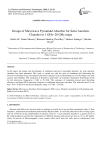
Design of Microwave Pyramidal Absorber for Semi Anechoic Chamber in 1 GHz~20 GHz range
Статья научная
In this paper, the design and development of wideband microwave pyramidal absorbers for semi anechoic chambers has been presented. This work is carried out with the goal of simulating and fabricating the microwave absorber using conventional and newest material such as polyurethane to save the budget cost with security and reliability. The simulation of absorber is performed via Computer Simulation Technology (CST) for the microwave frequencies 1 GHz to 20 GHz. The outcomes of simulation proved good absorbing efficiency and better RCS reduction compared to traditional microwave absorber. The reflection level is less than -30 to -10 dB over the desired frequency range of 1 GHz ~ 20 GHz.
Бесплатно
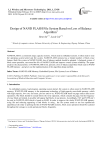
Design of NAND FLASH File System Based on Loss of Balance Algorithm
Статья научная
NAND FLASH is a commonly large capacity memory, which used in embedded systems .It often used to store the operating system kernel and file system. NAND FLASH memory has a limited number of block erase feature. Built file system in NAND FLASH, loss of balance method should be adopted. A balanced system of block erase operation, can extend the life of NAND FLASH and improve overall system reliability. The paper analyzes the characteristics of NAND FLASH work .presents a loss of balance algorithm which used in NAND FLASH memory , and given out the implementation of the algorithm design method.
Бесплатно
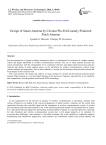
Design of Smart Antenna by Circular Pin-Fed Linearly Polarized Patch Antenna
Статья научная
For the transmission of signals at higher frequencies, there is a requirement for extension of a higher capacity system and higher bandwidth in wireless communication systems. The use of smart antenna increases the system performance with the arrangements of its constituent elements and digital signal processing capacity. Analysis and design of smart antenna arrays can be performed for wireless communication systems using various methods and approaches. One of these methods is circular pin-fed linearly polarized patch antenna has been adopted in this research work. This work presents the design and analysis of smart antenna by circular pin-fed linearly polarized patch antenna. Patch antenna is a very prominent antenna in the microwave frequency spectrum due to its simplicity and compatibility with the printed circuit board (PCB) technology.
Бесплатно
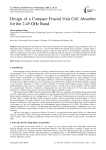
Design of a Compact Fractal Unit Cell Absorber for the 2.45 GHz Band
Статья научная
This paper presents the design of a fractal unit cell absorber for electromagnetic energy absorption in the 2.45 GHz band. The configuration is based on a second-order Minkowski-inspired fractal geometry, through which a compact structure is realized. The proposed design is achieved using full-wave electromagnetic simulations and the study of an equivalent circuit model. At 2.45 GHz, the synthesized structure achieves a near-perfect absorptivity of 99%, with a modest footprint of 0.11λ. The realized structure can serve as a constituent element for the design of absorber arrays to mitigate multipath effects and prevent eavesdropping attacks in indoor wireless environments.
Бесплатно
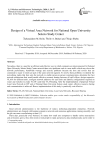
Design of a Virtual Area Network for National Open University Sokoto Study Center
Статья научная
Nowadays, there is a need for an efficient and effective way in which computers are interconnected. In National Open University Sokoto Study Center network there exist problems such as: more traffic which may slower the network performance, bandwidth wastage and security problems because the host and servers that are connected to Layer 2 switch are part of the same network segment. To resolve these problems we identify the networking media that best suits the network to enable person-to-person communication, determine the best network architecture that would enable effective resource sharing between all staff offices, design respective VLANs for different units, configure network addresses for each units and identify configurations required on router and switches to create VLAN’s and Inter VLANrouting. After the implementation of proposed Virtual Local Area Network in ICT unit of National Open University Sokoto study center, effective resource sharing and communication is achieved. Hence, implementation of this study is practically cost effective.
Бесплатно
Design of an IoT-Enabled Solar Tracking System For Smart Farms
Статья научная
This paper presents a novel IoT system to eliminate the need for human intervention for solar panel maintenance purposes in smart farms. For the convenience of the consumer, a wireless sensing system could be implemented to automate these functions. This would eliminate the cost of any additional labor charges for panel maintenance as the system implemented would automatically calculate the position as per the current time of the day and adjust the panel's position accordingly to harvest the most amount of sun rays into the PV panel. Unlike the conventional tracking method where the panel is rotated hourly, we propose a fixed set of Sun Altitude and Azimuth angle ranges that are hardcoded to each panel position so that throughout the year whenever these angles fall out of range it jumps to the next position. The system results in a straightforward method by retrieving the current date/time from the RTC module and calculating the respective Sun Altitude and Azimuth angle to determine the position to adjust the position of the panel accordingly, thus producing effective power outputs and strong sun tracking results.
Бесплатно
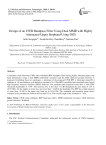
Design of an UWB bandpass filter using dual MMR with highly attenuated upper stopband using DGS
Статья научная
A miniature sized microstrip UWB (ultra wideband) BPF (bandpass filter) having highly attenuated upper stop band performance using a dual MMR (multimode resonator) and the DGS (defected ground structure) is proposed. Combining these two topologies, a prototype of the proposed UWB BPF is fabricated using FR-4 substrate of 1.6 mm thickness with dielectric constant of 4.4. This BPF is modelled and simulated using Ansoft high frequency structure simulator (HFSS) Software. The simulated and measured results show a wide FBW (fractional bandwidth) of 119% .The insertion loss is less than -1.0 dB throughout the pass band of 2.78 to 10.95 GHz. All the ripples of return loss are lower than -14 dB in the passband. The BPF has a high rejection of more than -30 dB in the upper stop band up to 16.8 GHz. The simulated and measured group delays variation in the passband are found to be less than 0.2 ns. The overall length of the resonator is 7 mm.
Бесплатно
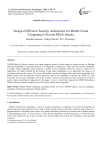
Design of effective security architecture for mobile cloud computing to prevent DDoS attacks
Статья научная
A DOS (Denial of Service) attack, as its name suggests, denies or blocks access to certain services by flooding either the bandwidth of a specified network or by targeting its connectivity. There are much security challenges in mobile cloud computing. Cloud indicates a period of the computing where the services, which are an application, are made available by the internet. Cloud based computing is very adjustable and cheap as to providing a platform for various IT services. The mobile systems can hinge on the cloud based computing with mobile agents and can undertake various processes such as the searching or storing, etc. While it’s very economic, it has many challenges such as the security. Various researches have been carried out to build a secure mobile cloud based computing. In this paper, we have viewed and analyzed the DDOS (Distributed Denial of Service) attacks in depth to prevent it in the mobile cloud computing.
Бесплатно
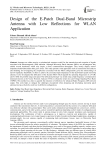
Design of the E-Patch Dual-Band Microstrip Antenna with Low Reflections for WLAN Application
Статья научная
Antennas are either massive or miniaturized structures useful for the transmission and reception of signals associated with Electromagnetic (EM) radiation. Although Microstrip Patch Antennas (MSA) are advantageous they exhibit several drawbacks which may impair a faster communication throughput. They mostly display narrow impedance bandwidth amidst other grave issues. This study presents some approaches such as transmission line analysis and modeling for investigating the complexities associated with the MSA configurations given the shortcomings of narrow impedance bandwidth. in other to achieve the associated input impedance for the dual-band E-patch microstrip antenna. It also investigated the fabrication of the E-patch MSA which targeted the operating frequencies of 2.4 GHz and 5.8 GHz for possible range and speed. The fabricated prototype was tested using a high-frequency communication instrument known as the Vector Network Analyzer (VNA) to obtain the return loss and Voltage Standing Wave Ratio (VSWR). This method was done to quantify the reduction of reflections for enhanced Radio Frequency (RF) network output. This work helps to mitigate the challenges encountered when designing and developing microstrip patch antennas having a relatively small size in different configurations.
Бесплатно

Design on open-loop bandpass filter with multiple harmonics suppression
Статья научная
In this paper, a simple method based on coupling control theory to suppress multiple harmonics in open-loop bandpass filters is proposed. Coupled feeding is utilizing in this paper, and by choosing proper coupling length and position of the input/output port, multiple harmonics could be suppressed. The input impedance of microstrip line with its end open-circuited is firstly showed and the theory on harmonics suppression is then analyzed to choose a proper coupling position. A second-order open-loop bandpass filter is designed and manufactured, measured and manufactured results both have a stopband to 5f0 with rejection more than 20dB. On the base of the filter proposed, the stopband can be broaden to 10f0 by adding two stubs. It well validates the proposed solution.
Бесплатно
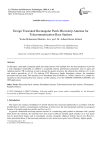
Design truncated rectangular patch microstrip antenna for telecommunication base stations
Статья научная
In this paper a truncated rectangular patch microstrip antenna with multiple slots has been proposed, to provide a wide impedance bandwidth, in addition to acceptable antenna performance parameters such as (gain and radiation pattern). FR-4 substrate is used to design the antenna structure, the substrate has thickness of 1.6 mm and relative permittivity of 4.3. By utilizing CST Microwave Studio Simulation softwer, the simulation procedure has been done. This antenna covers broadband from (0.94GHz to 3.4GHz), therefor it is suitable for operation in telecommunication base stations, and the antenna covers the GSM900, GSM1800, GSM1900, and IMT applications.
Бесплатно
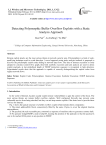
Detecting Polymorphic Buffer Overflow Exploits with a Static Analysis Approach
Статья научная
Remote exploit attacks are the most serious threats in network security area. Polymorphism is a kind of code-modifying technique used to evade detection. A novel approach using static analysis methods is proposed to discover the polymorphic exploit codes hiding in network data flows. The idea of abstract execution is firstly adopted to construct control flow graph, then both symbolic execution and taint analysis are used to detect exploit payloads, at last predefined length of NOOP instruction sequence is recognized to help detection. Experimental results show that the approach is capable of correctly distinguishing the exploit codes from regular network flows.
Бесплатно
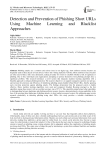
Detection and Prevention of Phishing Short URLs Using Machine Learning and Blacklist Approaches
Статья научная
Phishing attacks are a common and serious issue in our digital age, short uniform resource locators are frequently used in these attacks to trick unwary visitors into visiting malicious websites. Short uniform resource locators are often used to hide a link's true destination, making it harder for visitors to establish whether a link is legitimate or phishing. Due to this, individuals and organizations attempting to protect themselves from phishing attempts have a significant problem. This research introduces a novel system that integrates machine learning algorithms with a blacklist approach to enhance phishing detection. The system's objective is to support transparency protect user privacy, and increase the precision and efficiency of identifying phishing attacks hidden behind Short URLs, thereby granting users real-time protection against phishing attacks. The findings demonstrate that the proposed system is highly effective. Many machine learning algorithms were used and compared, Gradient Boosting emerged as the best algorithm among those tested, with an excellent accuracy rate of 97.1%. This algorithm outperformed other algorithms in distinguishing between legitimate and phishing uniform resource locators, demonstrating its strong capabilities in the face of the growing threat landscape of phishing attacks via short uniform resource locators. By addressing gaps in prior research, particularly in detecting phishing using short URLs, this study provides a valuable contribution to cybersecurity.
Бесплатно

Detection and extraction of OFDM parameters using difference of gaussians
Статья научная
Signals type detection is very important in telecommunication. Telecommunication signals can be divided into two major groups: single-carrier signals and multi-carrier signals. The first step in extracting data in multi-carrier communication signals is to detect signals and their subcarriers. OFDM signals are one of the most popular multi-carrier signals that are used widely. This paper will introduce a blind detection method for OFDM signals, subcarriers, and the central frequency of them based on the Difference of Gaussians (DoG) technique which is applied for blob detection in machine vision. Performance of our method is compared with high-resolution spectral estimation such as Capon, Borgiotti-Lagunas, and MUSIC. Results showed that it has less computational complexity than the others. Also, there is no need to learn parameters, so the response time of the system is appropriate. Furthermore, many tests have been done on real and artificial signals corrupted with noise and fading and the results showed our proposed method has better performance and cause the lower error in the severe condition like SNR=0.
Бесплатно
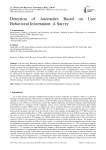
Detection of Anomalies Based on User Behavioral Information: A Survey
Статья научная
User and entity behaviour analytics (UEBA) solutions are becoming more and more popular for detecting anomalies since they establish baseline models of typical user behaviour and highlight deviations from them. Modelling normal user behavior and identifying any new behavior that deviates from the normal model user i.e., an attack, which is the main concept of Anomaly Detection (AD) techniques. In this work, a comprehensive review of various AD techniques based on user behavior is presented. Accordingly, this survey is concerted on various techniques employed for AD based on user behavior. Among various research articles, 50 research articles based on AD are considered and categorized based on different parameters, like techniques, publication year, performance metrics, utilized tools, and so on. At last, the research gaps and challenges of this method are illustrated in such a way that a goal for emerging an efficient technique for allowing the effective AD technique is defined.
Бесплатно
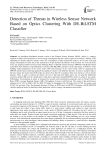
Detection of Threats in Wireless Sensor Network Based on Optics Clustering With DE-BiLSTM Classifier
Статья научная
An intelligent distributed network system is the Wireless Sensor Network (WSN), which is a strategy required to address security threats as well as energy consumption that has a direct impact on a network’s lifetime. Thus, attempting to identify malicious attacks with a low consumption of data transmission makes a lot of sense. The high energy consumption of nodes due to the transmission of data shortens the lifetime of the network. To overcome these issues, the proposed method is based on the Ordering Points to Identify Cluster Structure (OPTICS) with Bi-directional Long Short Term Memory using Differential evolution (DE-BiLSTM) classifier to detect the threats in WSN for smart building. Initial deployment of the sensor nodes (SN) and formation of the cluster nodes (CN) by employing the OPTICS density-based clustering approach that partitions clusters with different densities. In order to transport data to the base station, the cluster head (CH) nodes are chosen from the CN according to their more energy as well as shorter distance. Then, in order to forecast the threats, the size of the batch and hidden layers are set using the differential evolution method (DE) and the classification of the data is performed using BiLSTM to detect as attack or non-attack. Performance for predicting an attack is measured by network and classification parameters such as Packet Delivery Ratio (PDR), Average Residual Energy (ARE), Throughput, Accuracy and Precision. The results of the performance obtained are 91.78% for PDR, 8.56J for ARE, 2.52mbps for throughput with 100 nodes, then 93.78% for accuracy and 93.04% for precision. Thus, the designed detection of threats in WSN based on OPTICS clustering with DE-BILSTM classifier performs better for malicious attack prediction with low energy consumption sensor nodes.
Бесплатно

